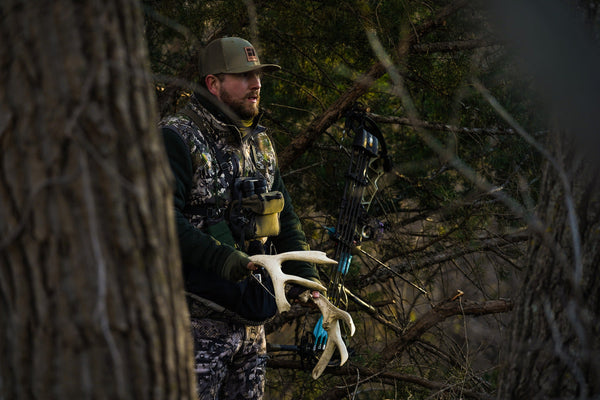Top Camo Patterns for Whitetail Hunting: Which One is Right for You?
Nov 01, 2024
Whitetail hunting is an exciting and challenging pursuit that requires patience, skill, and most importantly, the ability to remain undetected. Whitetail deer are notorious for their sharp vision and cautious nature, making concealment one of the most critical factors for success. Choosing the right camouflage can make all the difference in staying hidden and increasing your chances of a successful hunt.
In this guide, we'll break down the top camo patterns for whitetail hunting and help you understand which one is right for your hunting conditions. Whether you're in a dense forest, open field, or snowy terrain, choosing the right pattern will help you blend into your surroundings and improve your stealth.
Want Clarity on Camo Patterns?
SKRE Gear® has high quality hunting gear that is in multiple camo patterns. Learn more about the patterns in our blog post,
Read our Camo Patterns Explain Blog
Why Choosing the Right Camo Pattern Is Important
Whitetail Deer Vision and Behavior
Whitetail deer have remarkable vision and are highly sensitive to movement. While they don’t see colors in the same way humans do, they are particularly good at detecting shades of blue and yellow. They also pick up on contrast and movement much better than humans. For this reason, wearing camouflage that breaks up your outline and blends into the natural environment is essential for staying hidden from these keen-eyed animals.
Camo's Role in Concealment
Camo works by helping you blend into your surroundings and break up your silhouette. The right camo will make it difficult for a deer to distinguish you from the natural landscape. But not all camo patterns are created equal—different terrains and weather conditions require different types of camo for maximum effectiveness. Let’s explore the best camo patterns for various whitetail hunting environments.
Top Camo Patterns for Whitetail Hunting
Woodland Camo
Woodland camo is specifically designed for heavily forested areas where green, brown, and black tones dominate. The patterns mimic the shadows, leaves, and

bark found in dense forests, helping hunters stay concealed in areas with thick vegetation. This camo is most effective in early-season hunts when foliage is still vibrant.
- Best Environments: Thick woods, forested areas, and early-season hunts.
- Top Brands/Examples: For excellent woodland camo options, SKRE Gear offers the Summit Pattern. The Summit Pattern provides exceptional concealment in densely forested environments, helping hunters blend seamlessly with trees, leaves, and shadows.
Open Terrain Camo
When hunting in more open areas, such as fields or farmland, open terrain camo is your best bet. This camo typically features lighter tones of brown and tan to match dry grass, brush, and sparse trees. In open terrain, concealment often relies more on blending in with natural land features like dried vegetation or scrub than with dense foliage.
- Best Environments: Open fields, sparse woods, farmland, and later-season hunts when the landscape is more exposed.
- Top Brands/Examples: SKRE Gear’s Summit is an excellent choices for open terrain camo, designed specifically to help you blend into drier, less vegetated landscapes. This pattern offers high versatility and effective concealment in open fields, sparse woods, and brushy environments, allowing hunters to stay hidden in areas with lighter, earth-toned vegetation.
Snow Camo
For hunters in colder climates or during late-season hunts when snow covers the ground, snow camo is essential. This pattern typically features white, gray, and

light blue tones to blend into the snow and ice. Snow camo is especially effective when hunting in areas where the ground is entirely white, reducing the chances of being spotted by deer that are well-adapted to cold, snowy conditions.
- Best Environments: Snow-covered landscapes, late-season hunts.
- Top Brands/Examples: SKRE Gear's Summit Series and Ptarmigan Line offer excellent snow camo options designed to keep you fully concealed in a winter wonderland. These high-performance patterns blend seamlessly into snowy landscapes, ensuring that you stay hidden while also enjoying warmth and weather protection during late-season hunts.
Multi-Terrain Camo
If you're hunting in an area with mixed landscapes—perhaps where forest meets open field or brush—multi-terrain camo is your best option. These patterns combine green, brown, and tan tones to adapt to various environments. Multi-terrain camo is versatile, making it ideal for hunters who may move between different types of terrain throughout their hunt.
- Best Environments: Mixed terrain, areas with both vegetation and open spaces.
- Top Brands/Examples: SKRE Gear's Summit and Uinta Patterns are excellent examples of multi-terrain camo that can help you stay concealed across diverse landscapes. These patterns are designed to blend seamlessly in various environments, from dense woodlands to open fields, making them a versatile choice for hunters navigating multiple terrains.
Want Clarity on Camo Patterns?
SKRE Gear® has high quality hunting gear that is in multiple camo patterns. Learn more about the patterns in our blog post.
Read our Camo Patterns Explained Blog
Factors to Consider When Choosing a Camo Pattern
Time of Year
The time of year plays a significant role in choosing the right camo. Early-season hunts typically take place in lush, green environments where woodland camo is ideal. As the season progresses and leaves fall, open terrain camo becomes more effective. Late-season hunts in snowy conditions call for snow camo to ensure full concealment.
Location and Terrain
Where you hunt is just as important as when you hunt. If you're hunting in dense forests with heavy underbrush, woodland camo will help you stay hidden. If you're hunting in open fields, choose a camo pattern that matches the dry grass and sparse trees. Consider the landscape and adjust your camo to blend with your surroundings.
Weather Conditions
Weather conditions can drastically change the landscape. A fall hunt might start in a wooded area, but as the season changes, snowfall could require a switch to

snow camo. Similarly, rain or fog might make certain camo patterns less effective, so having a backup plan for various weather conditions can improve your chances of staying undetected.
Layering Camo for Complete Concealment
Base Layers and Outer Layers
To stay comfortable and concealed, layering your camo is crucial. Start with a camo base layer that provides warmth and moisture control. Then, add a mid-layer for insulation, particularly in colder weather. Your outer layer should be waterproof or wind-resistant, depending on the weather conditions. The key is to keep your camo pattern consistent across layers so your outline is fully concealed.
Accessories for Full Concealment
Don't forget accessories like gloves, face masks, and hats. Exposed skin can easily catch a deer’s attention, especially when it reflects light or moves. Camo gloves and face masks will help ensure that you stay completely hidden. Choose these accessories in the same camo pattern as your clothing to maintain full concealment.
Tips for Testing and Adjusting Camo
Testing Your Camo in the Field
Before heading out on your hunt, take time to test your camo in the environment

you’ll be hunting in. Walk through the woods, fields, or snow and observe how well your camo blends in with the surroundings. Look at your reflection in various lighting conditions to see if you’re standing out.
Adapting Camo for Changing Conditions
Be prepared to adjust your camo if the conditions change unexpectedly. For example, if snow begins to fall and you’re wearing a woodland camo, you might want to switch to snow camo to stay hidden. Always keep backup layers and accessories on hand for quick adjustments to match the changing environment.
Conclusion
Choosing the right camo pattern for whitetail hunting is about more than just picking a design you like—it’s about understanding the landscape, weather, and time of year. Woodland camo works best for dense forests, open terrain camo for fields and farmland, and snow camo for late-season winter hunts. Multi-terrain camo can provide versatility for hunters moving between different environments.
Remember, the goal is to break up your silhouette and blend into your surroundings as much as possible. Testing your camo in the field, layering for comfort and concealment, and being prepared to adjust based on conditions are all essential strategies for a successful whitetail hunt.
Now that you know the top camo patterns for whitetail hunting, it’s time to gear up! Explore our recommended camo options and share your favorite camo patterns and hunting experiences in the comments below.



